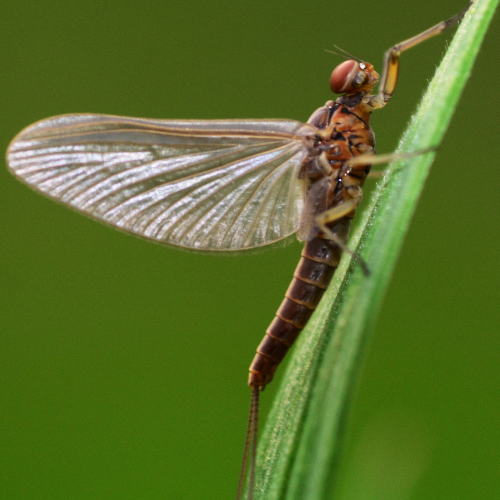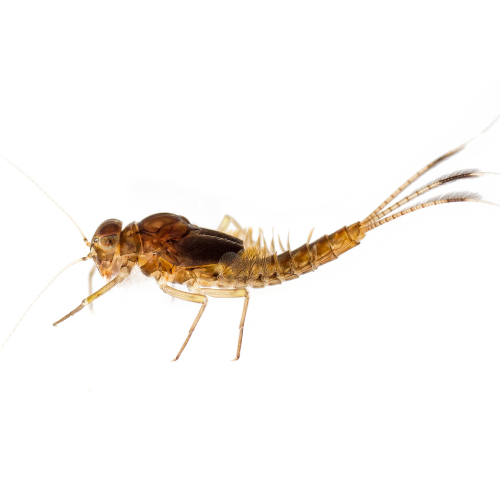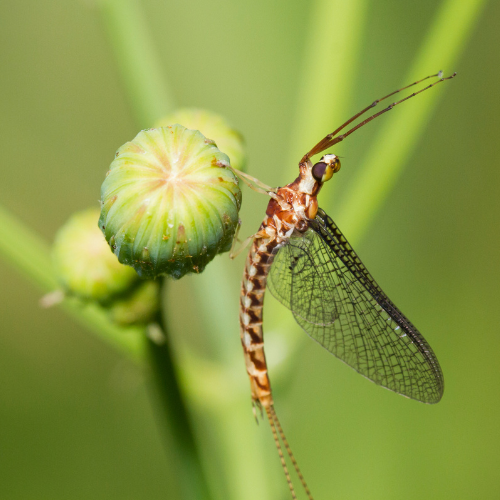Mayflies
Introduction to
Mayflies are unique and fascinating insects that play a crucial role in the ecosystem, particularly in aquatic environments. Known for their ephemeral adult lives, these insects are often seen in large swarms near bodies of water. This guide provides detailed information on how to recognize, understand, and manage mayflies, including preventive measures and professional pest control solutions.
Recognition
Mayflies are delicate, slender-bodied insects with two or three long tail filaments and membranous wings. The forewings are large and triangular, while the hindwings are much smaller or sometimes absent. Adults typically range from 1/4 to 1 inch in length. Mayflies are usually brown, yellow, or green, and their wings often have a translucent appearance. They are often seen swarming near water sources, such as rivers, lakes, and streams. The presence of large numbers of mayflies can be startling but is usually short-lived.
Biology
Mayflies belong to the order Ephemeroptera, which reflects their short adult lifespan. They undergo incomplete metamorphosis, with life stages that include egg, nymph, and adult. Mayfly nymphs, also known as naiads, live in freshwater habitats for several months to years, depending on the species. They have elongated bodies with gills along the sides of their abdomens and feed on algae, detritus, and microorganisms. After multiple molts, nymphs emerge from the water, undergo a final molt to become winged subimagoes, and soon molt again into sexually mature adults. Adult mayflies do not feed and live for just a few hours to a few days, primarily to mate and lay eggs.
Habits
Mayflies are aquatic insects, with nymphs residing in the sediment of freshwater bodies. They are most active during the warmer months when they emerge en masse to breed. Adult mayflies are often seen swarming in large numbers near water sources, where they mate and females return to the water to lay eggs. These swarms can create a spectacle but can also be a nuisance when they gather around lights or cover surfaces near water. While they do not bite, sting, or damage structures, their sheer numbers can be overwhelming during peak emergence periods.
Prevention
Preventing mayfly swarms indoors involves reducing the attraction of lights and sealing entry points. Use yellow or sodium vapor lights outside to minimize attraction, as these are less attractive to mayflies. Turn off unnecessary outdoor lights during peak emergence times and use curtains or blinds to reduce indoor light visible from outside. Ensure that windows, doors, and other potential entry points are well-sealed with weather stripping and screens. Additionally, using fans to create airflow can help deter mayflies from congregating near entrances.
Professional
When mayflies become a persistent problem, professional pest control services can offer effective solutions. STL Pest Control provides comprehensive inspections and tailored treatment plans to address mayfly swarms. Their methods include advising on lighting solutions, sealing entry points, and using non-toxic deterrents to manage mayfly populations. Professional services ensure that the infestation is managed efficiently and safely, reducing the inconvenience and potential nuisance caused by these seasonal insects.



Our Office









